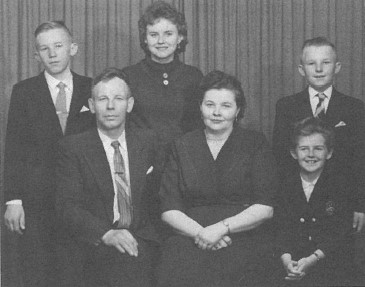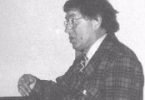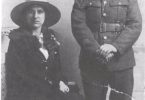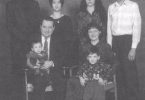My husband Alexander and I left Belgium with our daughter and two sons and arrived in Canada in May of 1951. Like so many others, we had originally come from Eastern Europe and were hoping for a better life. A friend who had immigrated earlier had written to us from Alberta, saying that Canada was a good place.
They found a southern Alberta sugar beet farmer who guaranteed us a place to live and work. This assisted us to get our immigration to Canada, but we were responsible for paying our own transportation costs to a place called Lethbridge, Alberta. We saved and even borrowed money from a friend to pay for the boat fare from Rotterdam, Holland to Quebec; then we boarded the train across Canada with only $4.00 in our pockets. It was a long, hungry trip as we wanted to save as much of this money as possible.
The farm was located three miles outside the small town of Picture Butte, which was twenty five miles outside of Lethbridge. At that time our eldest daughter, Vera, was nine years old; Victor was five years; and Valentin was two years old.
We worked the sugar beet fields seven days a week, from morning to night. We repaid our friends in Belgium immediately because they, too, wanted to immigrate to Canada and needed money to pay their own fares. On January 31, 1952, I gave birth to a baby girl whom we named Valentina.
The farm work was seasonal and later my husband began working in a coal mine near Lethbridge one day a week. It was not enough to support us, so he went to work in the coal mine in Coleman, Alberta.
In March of 1952, my husband, Alexander, heard through a friend that the coal mine in Canmore was hiring. He made his way to Canmore right away and Alex started work in Canmore on April 09, 1952. We first lived in Teepee Town, in a small cabin for a month, and then moved to the third floor of a house on what today is known as Sixth Street. That house was owned by Frances Grainger. Finally, a mine-owned apartment was available for us, and we moved to the end of a three-family house where the Canmore Clinic stands today. The only plumbing was a cold running water tap, but we were warm as there was a lot of coal to burn in the two stoves which heated the house.
One of my first memories when we arrived in Canmore was walking down the main street where Pauline and Jack Leong owned a coffee shop (corner of Eighth Street and Seventh Avenue). Pauline came out and kindly invited the children and me into their restaurant where we tasted Canadian ice cream for the first time. She could speak some Ukrainian and that helped us get to know one another. At that time there was a Catholic Convent in Canmore next to the Catholic Church and the nuns in residence offered kindergarten in the basement. They were very kind and fair to our youngest children and taught them to speak English.
In the winter of 1959, the weather was very bad but we had an appointment with the Government of Canada to take our citizenship in Calgary. The visibility was almost zero but we arrived for our appointment on time. Alex had studied particularly hard to learn all the answers to the questions asked by the Judge, and for us it turned out to be one of the sunniest days of our lives when we were finally sworn in as Canadian citizens.
In 1961, Canmore Mines began selling lots and houses to the workers. My husband bought a lot near the Bow River and by 1962, we started building our own house. We slowly built it with our savings and the help of friends who came out every weekend. By 1963 we had to move out of the mine house where we had lived for almost ten years. Dr. Alfred Miltins bought this property from Canmore Mines and wanted to start building the Canmore Medical Clinic. But even though our house wasn’t finished, it was a dream come true to move into our own home. It was the first time that we had running hot water, a bathtub, indoor plumbing, central heating and an electric stove.
In those days, the only work available in Canmore was for men, mainly in the coal mine; I worked at various jobs around Canmore and in Banff until I retired in 1975.
In 1976, it became known that my husband had Black Lung disease due to the many years of working underground in the mines. After suffering for many years, he passed away suddenly in February of 1986. We had built our lives and struggled together, endured many hardships and now I was alone after forty-seven years of marriage.
Today, in 1999, I live in the same house, keep busy at home and in the summer I enjoy working in my garden. I had a lot of pleasure in my involvement at the Canmore Seniors Drop-in-Centre where I volunteered for over sixteen years. It gave me pride to help in raising the initial building funds, serve on various committees and bake goodies and serve tea over those years, but poor health forced me to give up this activity. Like many seniors in Canmore, I have seen many changes. Some I like and some I do not like, but I do love Canmore as we were given an opportunity to build a life here. This is my home, as I have lived here longer than anywhere else in my life.
Vera married Leon Dyrgas of Canmore. They have two children, Stephen and Nadine. Victor lives at home with me. Valentin married Judy Ness who was from Exshaw and they have three children, Sasha, Jovena, and Elliot. Valentina married Dr. Surasakdi Sungkragorn, whom she met in Thailand, and they have one son, Arek.

back Victor, Vera, Valentin, front Alex, Nina, Valentina
In Canmore Seniors at the Summit, ed. Canmore Seniors Association, 2000, p. 22-23.







